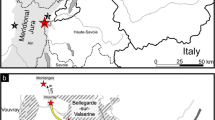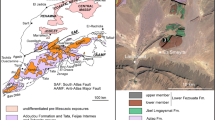Abstract
The Ribes de Freser area of the Eastern Pyrenees is characterized by an Alpine antiformal stack that comprises the so-called El Baell and Bruguera tectonostratigraphic units. This work presents detailed geological mapping and stratigraphic and facies analyses of these units, in order to improve the understanding of the Mid–Late Ordovician paleogeographical features of this sector of the Pyrenean margin of North Gondwana, subsequently affected by the Sardic Phase and the Variscan Orogeny. The Katian El Baell Formation, which crops out in the homonymous unit, is revised, formally erected and proposed as a lateral equivalent of the Estana Formation. The El Baell Formation consists of shale/limestone alternations where the carbonate production was controlled by development of pelmatozoan–bryozoan meadows and mud-mounds with plano-convex geometries and preservation of ramose bryozoans in life position. The thicker limestone levels, marking the top of shallowing-upward sedimentary cycles, contain fissure networks occluded with Pb–Zn–As ore mineralizations, whose clast counterparts occur forming overlying lags. The El Baell/Ansovell contact is marked by karstic clayey byproducts. Both the drastic changes in thickness and facies of the El Baell and Estana formations, and the presence of contemporaneous epithermal and fissuring episodes in the former, point to the onset of Katian (Late Ordovician) extensional tectonics, which may have controlled sharp modifications in accommodation space. Finally, the internal structure of the El Baell and Bruguera units are different, pointing to the record of a pre-Variscan (Mid Ordovician) deformational episode responsible for the dispersion of Variscan mesostructures in pre-Upper Ordovician rocks.
Resumen
El sector de Ribes de Freser, en el Pirineo Oriental, se caracteriza por un apilamento antiformal alpino compuesto por las llamadas unidades tectonostratigráficas de El Baell y Bruguera. El objetivo de este trabajo es profundizar en el conocimiento de estas unidades, a través de la cartografía geológica y el análisis estratigráfico, con el fin de contribuir a la comprensión de la influencia tectónica registrada a lo largo del Ordovícico Medio–Superior. Se revisa y se propone la Formación El Baell, de edad katiense, que aflora en la unidad de El Baell y se considera equivalente lateral de la Formación Estana. La Formación El Baell se compone de alternancias lutítico-calcáreas donde la producción carbonatada se relaciona con el desarrollo de praderas de pelmatozoos-briozoos y montículos micríticos con geometrías plano-convexas y conservación de briozoos ramosos en posición de vida. Los niveles más potentes de caliza, que marcan la parte superior de los ciclos sedimentarios de somerización, contienen redes de fisuras rellenas con mineralizaciones de Pb–Zn–As, cuyos clastos aparecen retrabajados en niveles suprayacentes. Asimismo, el contacto El Baell/Ansovell está marcado por subproductos arcillosos cársticos. Tanto los cambios drásticos de espesor y facies en las formaciones El Baell y Estana, como la presencia de episodios epitermales y de fracturación en el primero, apuntan al registro de una tectónica extensional, de edad katiense (Ordovícico Superior), responsable de cambios importantes en el espacio de acomodación. Por último, la estructura interna de las unidades de El Baell y Bruguera es significativamente diferente, señalando el registro de un episodio de deformación pre-Varisco (Ordovícico Medio) responsable de la dispersión de las mesoestructuras variscas que afectan a las rocas anteriores al Ordovícico Superior.










Similar content being viewed by others
References
Álvaro, J.J., & Van Vliet-Lanoë, B. (2009). Late Ordovician carbonate productivity and glaciomarine record under quiescent and active extensional tectonics in NE Spain. In: Bassett, M.G. (Ed.), Early Palaeozoic Peri-Gondwana Terranes: New Insights from Tectonics and Biogeography. Geological Society, London, Special Publications, 325, 117–139.
Ayora, C. (1980) Les concentrationes metàl·liques de la Vall de Ribes. PhD, Univ. Barcelona.
Casas, J. M. (2010). Ordovician deformations in the Pyrenees: new insights into the significance of pre-Variscan (“sardic”) tectonics. Geological Magazine, 147, 647–689.
Casas, J. M., & Muñoz, J. A. (1987). Sequences of mesostructures related to the development of Alpine thrusts in the Eastern Pyrenees. Tectonophysics, 135, 65–75.
Casas, J. M., Puddu, C., & Álvaro, J. J. (2017). Upper Ordovician limestones along the Ribes-Bruguera road. In: Álvaro, J.J., Casas, J.M., Clausen, S. (Eds.), Ordovician Geodynamics: the Sardic Phase in the Pyrenees, Mouthoumet and Montagne Noire massifs. Géologie de la France, 1(4), 40–41.
Cavet, P. (1957). Le Paléozoïque de la zone axiale des Pyrénées orientales françaises entre le Roussillon et l’Andorre (étude stratigraphique et paléontologique). Bulletin du Service de la Carte géologique de France, 254, 303–518.
Draidia, S., El Ouahabi, M., Daoudi, L., Harvenith, H. B., & Fagel, N. (2016). Occurrences and genesis of palygorskite/sepiolite and associated minerals in the Barzaman formation, United Arab Emirates. Clay Minerals, 51, 763–779.
Fontboté, J. M. (1949). Nuevos datos geológicos sobre la cuenca alta del Ter. Anales del Instituto de Estudios Gerundenses, 4, 1–57.
Gil-Peña, I., Barnolas, A., Villas, E., & Sanz-López, J. (2004). El Ordovícico Superior de la Zona Axial. In J. A. Vera (Ed.), Geología de España (pp. 247–249). Madrid: SGE-IGME.
Hammann, W. (1992). The Ordovician trilobites from the Iberian Chains in the province of Aragón, NE Spain. I. The trilobites of the Cystoid Limestone (Ashgill Series). Beringeria, 6, 1–219.
Hartevelt, J. J. A. (1970). Geology of the upper Segre and Valira valleys, central Pyrenees, Andorra/Spain. Leidse Geologische Mededelingen, 45, 167–236.
Martí, J., Casas, J.M., Guillén, N., Muñoz, J. A., & Aguirre, G. (2014). Structural and geodynamic constraints of Upper Ordovician volcanism of the Catalan Pyrenees. Gondwana 15 Abstracts book, 104.
Martí, J., Muñoz, J. A., & Vaquer, R. (1986). Les roches volcaniques de l’Ordovicien supérieur de la région de Ribes de Freser-Rocabruna (Pyrénées Catalanes): caractères et signification. Comptes Rendus de l’Académie des Sciences, Paris, 302(20), 1237–1242.
Martínez, F. J., Iriondo, A., Dietsch, C., Aleinikoff, J. N., Peucat, J. J., Cirès, J., et al. (2011). U-Pb SHRIMP-RG zircon ages and Nd signature of lower Paleozoic rifting-related magmatism in the Variscan basement of the Eastern Pyrenees. Lithos, 127, 10–23.
Morre-Biot, N., & Robert, J. F. (1976). Sur la découverte d’un complexe ignimbritique stéphanien dans la région de Ribes de Freser (Province de Gérone, Espagne). Comptes Rendus de l’Académie des Sciences, Paris, 282, 1933–1935.
Muñoz, J.A. (1985). Estructura alpina i herciniana a la vora sud de la Zona Axial del Pirineu oriental. PhD, Univ. Barcelona. Monografies núm. 1. Publicació del Servei Geològic de Catalunya. Generalitat de Catalunya, Departament de Política Territorial i Obres Públiques, Servei Geologic de Catalunya, Barcelona, 227 pp.
Robert, J.F. (1980). Étude géologique et métallogenique du val de Ribes sur le versant espagnol des Pyrénées Catalanes. PhD, Univ. Franche-Compté.
Robert, J. F., & Thiebaut, J. (1976). Découverte d’un volcanisme acide dans le Caradoc de la région de Ribes de Freser (province de Gérone). Comptes Rendus de l’Académie des Sciences, Paris, 282, 2049–2050.
Roqué Bernal, J., Štorch, P., & Gutiérrez-Marco, J. C. (2017). Bioestratigrafía (graptolitos) del límite Ordovícico-Silúrico en los Pirineos orientales (curso alto del río Segre, Lleida). Geogaceta, 61, 27–30.
Salvador A. (ed.) (1994). International stratigraphic guide, 2nd ed. Geological Society of America, 214 p. Boulder.
Sánz-López, J., & Sarmiento, G. N. (1995). Asociaciones de conodontos del Ashgill y Llandovery en horizontes carbonatados del Valle del Freser (Girona) (pp. 157–160). Tremp: XI Jornadas de Paleontología.
Vennin, E., Álvaro, J. J., & Villas, E. (1998). High-latitude pelmatozoan–bryozoan mud-mounds from the late Ordovician northern Gondwana platform. Geological Journal, 33, 121–140.
Acknowledgements
We thank the constructive criticism made by two anonymous reviewers. C.P. thanks Prof. C. Corradini for allowing the use of laboratories in the Cagliari University (Department of Earth Sciences), and S. Unida who provided the techniques for unsuccessful palynological preparations. M. Sánchez-Román (VU, Amsterdam) and J. Ibáñez (ICTJA, Barcelona) are thanked for XRD interpretation. Financial support for this work was provided by CGL2015-66335-C2-1-R and CGL2017-87631-P projects from Spanish MINECO.
Author information
Authors and Affiliations
Corresponding author
Rights and permissions
About this article
Cite this article
Puddu, C., Álvaro, J.J. & Casas, J.M. The Sardic unconformity and the Upper Ordovician successions of the Ribes de Freser area, Eastern Pyrenees. J Iber Geol 44, 603–617 (2018). https://doi.org/10.1007/s41513-018-0084-0
Received:
Accepted:
Published:
Issue Date:
DOI: https://doi.org/10.1007/s41513-018-0084-0




